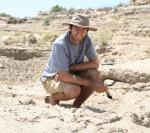Kevin Hatala

Kevin Hatala is interested in postcranial functional morphology and the evolution of human gait. Specifically, he is interested in combining experimental biomechanical studies with analyses of the fossil record to better understand the evolutionary history of human locomotion.
2010-present Koobi Fora Field School and Research Project, Rutgers University and the National Museums of Kenya
2010-present Engare Sero Footprints Project, Engare Sero, Tanzania
2010 UNLV Short Course in X-ray Reconstruction of Moving Morphology (XROMM)
2009 Undergraduate Honors thesis: ‘Activity-related changes in geometry of the proximal femur: A study of two Near Eastern samples.’ Duke University, Advisor: Dr. Steven Churchill
2008 NSF-REU in Biocultural Anthropology, University of Notre Dame
2012-2014 Wenner-Gren Foundation, Dissertation Fieldwork Grant, “A novel experimentally-based investigation of Plio-Pleistocene fossil hominin footprints.”
2012-2014 National Science Foundation, Doctoral Dissertation Improvement Grant, “Fossil footprints and the dynamics of footprint formation: Implications for the evolution of human gait.”
2012-2014 The Leakey Foundation, General Research Grant, “Fossil hominin footprints and the dynamics of footprint formation.”
2012 Evolving Earth Foundation, “A snapshot of the anatomy, locomotion, and social behavior of early modern humans as evidenced by fossil footprints at Engare Sero, Tanzania.”
2011 NSF Graduate Research Fellowship, Honorable Mention
2010 NSF Graduate Research Fellowship, Honorable Mention
2010 Lewis N. Cotlow Field Research Fund
2009 Trinity College Research Fund, Duke University
2009 Undergraduate Research Support Grant, Duke University
Human anatomy; Biomechanics; Locomotion; Human evolution
I am currently a National Science Foundation Social, Behavioral, and Economic Sciences Interdisciplinary Postdoctoral Fellow. My postdoctoral research fellowship is aimed at developing new methods that can be used to extract anatomical and functional data from footprints in the human fossil record. My approach combines ongoing paleontological excavations of fossil hominin footprint sites in Kenya with laboratory experimental projects aimed at modeling the ways in which locomotion is recorded in footprints. I am carrying out my postdoctoral research in collaboration with a variety of paleoanthropologists, evolutionary biologists, and computer scientists from the Max Planck Institute for Evolutionary Anthropology, the American Museum of Natural History, Brown University, and the University of Colorado-Boulder.
Journal Articles:
Hatala KG, Wunderlich RE, Dingwall HL, Richmond BG. (In review) Interpreting locomotor biomechanics from the morphology of human footprints. In review with the Journal of Human Evolution.
Grabowski MW, Hatala KG, Jungers WL, Richmond BG. (Accepted) Body mass estimates of hominin fossils and the evolution of human body size. Journal of Human Evolution.
Hatala KG, Dingwall HL, Wunderlich RE, Richmond BG. 2013. The relationship between plantar pressure and footprint shape. Journal of Human Evolution 65(1): 21-28.
Hatala KG, Dingwall HL, Wunderlich RE, Richmond BG. 2013. Variation in foot strike patterns during running among habitually barefoot populations. PLoS One 8 (1): e52548.
Dingwall HL, Hatala KG, Wunderlich RE, Richmond BG. 2013. Hominin stature, body mass, and walking speed estimates based on 1.5 million-year-old fossil footprints at Ileret, Kenya. Journal of Human Evolution 64(6): 556-568.
Book Chapters:
Richmond BG, Hatala KG. 2013. Origin and evolution of human postcranial anatomy. In: A Companion to Paleoanthropology, Begun D (ed.), Wiley-Blackwell. pp. 183-202.
Ph.D. 2014, The George Washington University
B.S. 2009, Duke University

